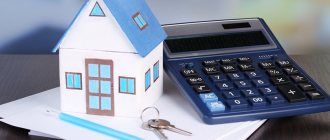What is the total area of residential and non-residential premises?
In an apartment building, in addition to the apartments themselves, there are also a huge number of premises that, for one reason or another, may be available to some residents. All such objects are considered common property and cannot be directly related to the area of the apartment.
The total area of an apartment in an apartment building (apartment building) is a space in which people can live with a certain comfort. The common space includes a living space; it is intended directly for the residence of the owners.
Three components
What is included in the living area of the apartment? Before you begin to understand this issue, you need to get acquainted with all the “dimensions” of the home. It has already been said that there are several of them. At the moment, we can distinguish 3 components of the apartment:
- living space;
- apartment area;
- total area.
Without this knowledge, it is impossible to say exactly which apartment you are agreeing to. Therefore, real estate sellers are always asked for this information. If you know what is included in each type of housing area, you can not be afraid of being deceived in real estate transactions.
What is living area and what is included in the total area
Most official documents contain the terms residential and total area of the structure. Both of these terms carry different meanings and require the assistance of a qualified professional in defining them. Before you begin the calculations, you need to understand what is included in the living area of the apartment. This knowledge will certainly be useful during redevelopment and registration of changes.
What is living space?
The Housing Code of the Russian Federation, which explains all the concepts in detail, will help answer this question. First of all, it’s worth understanding the terms that describe each of the individual types of zones.
The total area of an apartment is the total space, including both residential apartments and non-residential areas. However, this concept does not include terraces or loggias. Thus, all useful areas should be classified as living space.
The territory that reflects the total space of residential and non-residential areas of the structure, including utility rooms, is considered useful. It is this definition that should be adhered to in Russia. Other countries have a different point of view, calling only used territories useful.
The living area of an apartment is a zone that includes the sum of all apartments that are suitable for permanent residence, for example, a bedroom or a children's room. Such premises cannot include, for example, a kitchen or utility room.
What does living space include?
Official documents such as papers issued by the BTI can operate not only in terms of residential or total area. But it is precisely these terms, different in meaning, that most often appear in such documents.
How can you cash out maternity capital?
According to the norms of the Housing Code of Russia, the general space of a residential area, consisting of all existing apartments of a particular housing, can include the following:
- bathrooms and sanitary rooms;
- toilet;
- rooms with plumbing;
- kitchens and dining rooms;
- sleeping and children's apartments;
- corridors, hallways and storage rooms.
When calculating the total living area, it is important not to take into account the balcony, loggia or terrace.
Attention! In some cases, BTI specialists may include outdoor premises in the common space, but in such situations a reduced calculation coefficient will be applied, which is established by law in Russia.
In this case, the living area of the apartment includes the sum of the sizes of all premises suitable for living. Thus, this includes only internal rooms in which accommodation is possible.
It turns out that when calculating the living area, it is worth excluding bathrooms, kitchens, terraces and loggias, toilets, corridors or hallways, as well as various extensions, stairwells, niches and areas under the fireplace or stove.
Apartments that include living space calculated at the housing design stage must be indicated in the technical documentation and marked as residential.
Living space of a private house
To determine this value in a private house, everything is done in the same way as calculating the total area of the apartment. Only those apartments that are suitable for direct human habitation are also taken into account.
The following are not taken into account:
- verandas and storage rooms;
- porch and external stairs;
- attic spaces;
- parts of the building that are used for heating, as well as attached boiler rooms.
Everything and completely
Which one exactly? There is such a term as “apartment area”. Usually this means the entire apartment. All residential and non-residential premises, as well as other components.
The balcony is included in the area of the apartment. And the loggia too. Usually such space is also called useful. A variety of mezzanines are also included in the concept of usable area. In Russia this is exactly the interpretation used. But in other countries, usable area refers to only the usable premises in housing. What a mess!
Why is it not so easy to measure the area of an apartment?
If you take a closer look, you will notice that in the above documents the concepts “apartment” and “living premises” , which are somewhat different from each other. In particular, in the construction permit, a house with apartments will be called an apartment building, and with residential premises - an individual residential building (and the ownership of the land plot will indicate either “land of settlements - apartment building” or “land settlements - for individual residential construction"). Accordingly, the importance of balconies and loggias in the total area will also be considered based on what is specified in the contract - “apartment” or “residential premises”.
We recommend reading: Concept and Types of Areas of Activity of a Lawyer
Counting Rules
It’s good that it’s considered one of our main indicators that affects the value of real estate, we figured it out. Now it would be nice to understand how living space is calculated. This point is extremely important. After all, the cost of housing will directly depend on it.
Everything is easy and simple. We have already found out that a component of this space is the living room.
Then everything is simple. To understand how much area is allocated for living, you must first calculate the footage of each room, and then add the resulting values together.
And you will get the desired indicator. How is the area of a room calculated? Here the most common mathematical formulas for calculating the area of a square and rectangle come to the rescue.
All measurements must be taken on the inside of the baseboard.
How to determine
To find out what the living area is, you need to calculate the number of square meters of the entire space intended for living. This:
To obtain the quantity, each space is calculated separately. For example, in a one-room apartment this area is proportional to the parameters of the only room - the bedroom-living room, in a two-room apartment - the bedroom and living room.
Important!
Some people mistakenly attribute the kitchen or loggia to this space. But according to the Housing Code, this is a mistake. The dining area cannot be considered suitable for living, even if there is a bed there.
Non-residential area - the remaining space, including a corridor, kitchen, bathroom (bathtub and toilet), balcony, loggia. This includes storage rooms, hallways, and dressing rooms.
Everything is included The cost of repairs includes everything: work, materials, documents.
Without your participation After agreeing on the project, we only bother the owners when the repairs are completed.
The price is known in advance. The cost of repairs is fixed in the contract.
Fixed repair period Turnkey apartment renovation in 3.5 months. The term is fixed in the contract.
What's included additionally
Expert opinion
Smirnov Alexander Stanislavovich
Lawyer with 12 years of experience. Specialization: civil law. Member of the Bar Association.
When calculating the indicator of the living space of an apartment, you need to take into account that it often includes a number of additional elements. These include:
Partitions. According to SNiP (building codes and regulations), they cannot be skipped when determining the total footage suitable for living.
Niches. This includes only those that reach more than two meters in height.
Arches. Entered only if they meet the niche requirement above.
Stairs built indoors (for example, multi-level).
Heating stoves, other protruding elements.
To obtain accurate data without errors, owners often invite professional measurers. They carry out measurements taking into account building codes and the requirements of the Housing Code.
Why you need to know
The indicator of the total area of residential premises is used when:
calculating the amount of payment for utilities (if meters are not installed);
determining the owner’s share in the common property of an apartment building (the value of the share is proportional to the total number of common m2);
calculating the base for paying tax on land that is part of shared ownership;
establishing the required amount to pay residential tax and deduction (personal property tax);
calculating the cost of 1 square meter when buildings are recognized as unsafe and included in the program for relocating people.
This amount is necessary when determining the square footage allocated for ownership to social categories (disabled people, military) or participants in the subprogram “Providing housing for young families.” The figure will be needed when applying for a subsidy or determining how much the owner must pay for common house maintenance.
The calculation must be carried out when concluding a contract for the purchase and sale of real estate, a mortgage, or examining the living conditions of a minor by the relevant authorities.
Interesting fact!
The accepted property tax is determined by the size of the total, not residential footage. The fiscal service takes this information from the state register of property rights. This parameter is determined regardless of the redevelopment carried out, glazing work on a balcony or loggia.
What are the differences between the common area and the living area?
- Size. The living area is only a part of the total, which means that it is in any case smaller, most often significantly, almost twice.
- Included premises. Only a small part of the apartment belongs to the living area - bedrooms, living rooms and children's rooms, where the main part of human life takes place. The total area includes bedrooms, living rooms and children's rooms, as well as all other rooms.
- Application. The living space determines the living conditions (and therefore the ability to receive social subsidies or adopt a child), the total - the cost of the apartment and how much you will have to pay for its heating, as well as how much you will have to pay for major repairs of the entire house.
How to measure
Information for all rooms is indicated in the technical passport for the apartment. Sometimes it happens that there are discrepancies in the actual measurements. For measurements, in addition to the technical passport, you will need a tape measure, paper, calculator and pencil. The actions are:
The apartment diagram is drawn on a sheet of paper. You also need to draw utility rooms - storage rooms, built-in wardrobes.
Using a tape measure, measure the length of the walls according to the level of the baseboard. The amounts are converted into meters and recorded on the diagram.
If there are curves or recesses in the configuration of the room, it is divided into separate figures, each with its own value indicated.
Total area of the apartment - includes how to measure and calculation rules
First, draw a diagram of the apartment on a piece of paper. This will make it easier for you to enter the values on the plan. Don’t forget to take measurements in utility rooms – corridors, closets, and so on. It is necessary to measure the length of the premises according to the level of the baseboard. To do this, make sure that the tape measure is tensioned well and accurately. The sums of all measurements must be converted into meters and written down on a piece of paper. If the room has an irregular shape with protrusions, corners and curves, then it will be easier to divide the plan into separate figures and indicate their sizes on the diagram.
Calculation rules
This aspect needs to be given special importance. How is the total area of a two-room apartment determined? What indicators are taken into account? There are certain differences between the living area and the common area that should definitely be taken into account. These include:
Important! To avoid possible disagreements, when purchasing a home and preparing documents, be sure to check with the developer (seller) what calculation they take as a basis: with or without balconies, loggias, terraces, etc.
- Technical certificate.
- Inquiry as to whether construction work can be carried out.
- Ready redevelopment project.
- Documents confirming that the citizen is the owner of the property.
- Permission to carry out redevelopment from all co-owners.
- Technical expertise confirming that it is permissible to make changes to the current layout. Its results may prohibit doing this if the building of the house is, for example, dilapidated. This should be taken seriously.
Privacy Policy
Information that provides communication with the user is subject to collection. Also, automatically, data about the visit and the technologies used are saved in the server log, such as: IP address, data about the system and browser, URL of the transition, its date and time, etc.
The data collected by web analytics systems, as well as retargeting pixels, belongs to the corresponding services, the work with which is regulated by the privacy policies of these services. The installed web analytics systems include Yandex.Metrica, Liveinternet, Google Analytics and others.
Data from web analytics systems is collected automatically and used to improve the site "dariol.ru". Based on the collected data on the actions of visitors, we improve the functionality of the site and create high-quality content that is interesting to readers.
The information provided by the user is used to communicate with him, including to inform him about changes in the conditions of the service provided.
The transferred data is stored on secure servers that protect confidential information.
At the user's request, his data is deleted irrevocably within one business day.
The site administration guarantees protection from the transfer of personal data to third parties, except in cases provided for by the laws of the Russian Federation, such as:
- compliance with the law, regulatory acts, execution of court decisions;
- detecting or preventing fraud;
- receiving an official request from law enforcement agencies, etc.
Legal nuances related to the size of premises are of little interest to anyone in everyday life. At the same time, the living and total area of the apartment, the difference between which can be very significant, is used not only in technical descriptions of real estate.
These data are recorded in title documents and are the basis for calculating certain types of utility payments.
In addition to bedrooms, living rooms, offices and children's rooms, the apartment also has auxiliary rooms - kitchens, bathrooms, toilets, wardrobes and corridors. What category should we include and how should we take these premises into account in the residential or common area when exchanging apartments? But there are still balconies, what to do with them? There are no less difficulties with two-level apartments.
Staircase passages between floors also take up significant space. Let's understand the commonly used terminology together.
What is included in the living and common area of the apartment: what is it, definition
/ Housing disputes / Transfer of residential and non-residential premises / What is included in the residential and total area of an apartment
Having heard about the total and living area of an apartment, few of us attach any importance to this. However, there are times when you need to be aware of the differences between these concepts. One such situation is the purchase and sale of an apartment.
Imagine that a buyer calls you and asks – what is the living area of the property? This question is puzzling. You can confuse and name the total footage of the apartment, but this will be a mistake.
And there are plenty of such situations...
Which squares are included in the total area of the housing, and which are included in the living area? Where should I include the loggia, balcony, storage room and kitchen? Often you need to calculate your living space, but you don’t have a formula at hand. We will try to answer these questions in our article.
Total and living area - definitions
Housing is a building premises with technical and legal characteristics. The first step is to decide on the conceptual apparatus.
Definitions at the legislative level:
General - the total footage of all heated rooms and auxiliary premises in the apartment - bathroom, toilet, kitchen, pantry, closet, built-in closet, corridor and other premises (by virtue of clause 5 of Article 15 of the Housing Code of the Russian Federation).
Living room - a set of areas of heated living rooms in accordance with the layout of the apartment: bedroom, study, living room, children's room (provisions of the Order of the Ministry of Land Construction of the Russian Federation No. 37 of August 4, 1998).
What distinguishes living and common areas?
- Size (square meters). Of course, the total area of the apartment is much larger than its individual rooms - sometimes 2-3 times.
- Number of premises . The living area is represented only by places for people to live (children's rooms, bedrooms, living rooms). The total square footage of the apartment includes not only living rooms, but also non-residential premises (for example, a kitchen or bathroom).
- Operation (use). The living area does not reflect the market value of the apartment, since it only includes rooms for living. The price is based on the total area of the property. However, such space is in no way connected with the accounting norm per person, because Only the square footage of living rooms is taken into account. Consequently, there is a difference in purpose.
Somewhere there is a third concept - usable area . It refers to the sum of the entire space in the apartment, including an unheated loggia, balcony, and mezzanine. However, for modern use the concept of total square footage of housing is more often used.
What is the total area of residential and non-residential premises?
Property in an apartment building (MCD) is also divided into two types: residential and non-residential. The first type is represented by residential premises - apartments. The owners are their owners, on the basis of title documents (for example, a gift agreement).
The non-residential premises of apartment buildings include elevator shafts, attics, basements, strollers, stairwells, and vestibules . Objects are considered common property of an apartment building. They are enshrined in the MKD technical passport. Owners of housing have a share in the common property of the house in accordance with the area of the living space.
The total area of residential and non-residential premises in a house is needed primarily to calculate utility bills. Based on the footage of the management company, standards for the consumption of utility services are calculated (letter of the Ministry of Regional Development of the Russian Federation No. 29433-VK/19). Then calculations are made, and residents receive receipts for payment.
Does the total area include:
The area of an apartment is the totality of the space located in it. Disputes can often arise: should this or that room be considered a common space? We found out above that the rooms, kitchen, bathroom and corridor are included in this footage. It remains to deal with other parts of the apartment and house.
Basement
It is found mainly in private houses, less often in apartments. To determine whether the basement is included in the total area of the housing, you need to evaluate its technical parameters. Namely, heating.
If the basement is not heated, then it is not part of the total footage in the apartment. Conversely, if it has heating, the basement has probably been turned into a living room.
Porch
A private house may have a staircase and a porch. Even if there is a sleeping place on it, there are chairs and a table - the porch is not part of the total living area. And even more so, it cannot be included in the living space, since the porch is located outside the private house.
Attic
There are known cases when a non-residential attic of an apartment building became the property of the apartment owner. Most often this was used by residents of the upper floors. This is typical for both low-rise buildings and high-rise buildings. Along with redemption, privatization of the attic is also practiced.
Only in this case can the attic space be classified as the common property of the apartment. This will require, at a minimum, the reconstruction of the existing space: electricity supply, heating, and other components.
An attic that does not have heating is not the common property of the apartment.
Attic
A private house can be equipped with an attic - an upper extension in the roof. Typically, the attic has sloping walls and windows, but is connected by common communications to the residential building. Information about the object is included in the registration certificate of a private house.
How to determine? If the attic serves as a living space with heating , then it is a living space and part of the common property. A technical room is not such a thing.
Partitions
Individual spaces in the apartment can be separated using partitions. The question arises: should they be included in the total area of housing?
The Housing Code defines partitions as part of the common property . Indeed, this is one of the attributes of apartment redevelopment. The height of the partitions is usually from 1.1 to 1.3 meters to the ceiling.
Is the accounting standard for housing the total or living area?
Legal reference books contain the term “accounting norm for housing”. Some say that it refers to a general quadrature, others - that it refers to a residential quadrature. It is more logical to turn to the legislation and find out the truth.
So, the accounting norm is the minimum size of the area of an apartment/house per person who needs residential premises (clause 4 of article 50 of the Housing Code of the Russian Federation). The reference point is the living space - bedrooms, offices, living rooms, children's rooms, etc.
The size of the accounting norm is established by the local administration in each specific region of the Russian Federation. True, the calculations are not lower than federal indicators for the country as a whole. For example, in Moscow you can register as needing housing if the norm is 10 m². For comparison, in St. Petersburg – 9 square meters.
Source: https://law-divorce.ru/chto-vhodit-v-zhiluyu-i-obshhuyu-ploshhad-kvartiry/
Main technical and economic parameters of the apartment
The concept of the total area of premises is enshrined in law. Article 15 of the RF Housing Code in the fifth paragraph provides a precise definition of this indicator and what parts it consists of.
In fact, this is the sum of the areas of all, including auxiliary, premises. Only unheated parts are not taken into account, which include external structures - loggias and balconies.
There is no definition of living space in the mentioned code.
When determining the technical and economic indicators of housing, the instructions introduced by the order of the Ministry of Land Construction of the Russian Federation dated August 4, 1998 No. 37 are used. This document specifies the list of premises that are taken into account in the total area: kitchens, dining rooms, bathrooms, toilets, corridors, hallways, as well as built-in building structures cabinets.
Reducing factors are applied to individual parts:
- balconies – 0.3.
- unheated pantries – 1.0.
- loggias – 0.5.
The mentioned document also introduces the term “living area”, which means the sum of the areas of all residential premises. Such rooms should include bedrooms, children's rooms and living rooms. The said instructions also mention such a parameter as the area of the apartment, which is essentially equal to the total area. This further complicates the situation.
What is the total area of the apartment
In the technical passport for an apartment or house you can see the total area of the apartment in numbers. In ordinary everyday life of apartment owners, the total or residential area of the housing does not matter much. But when buying or selling residential real estate, the size of the area affects the cost of the apartment.
The total area (So) is the sum of the areas of all rooms of an apartment or house. It is this indicator that is taken into account when calculating the market and cadastral value of the apartment.
Sо of an apartment in 2017-2018 is determined as the sum of the areas of its premises, built-in wardrobes, as well as the areas of loggias, balconies, verandas, terraces and cold storage rooms, calculated with the following reduction factors: for loggias - 0.5, for balconies and terraces - 0 ,3, for verandas and cold storerooms - 1.0.
This is exactly the definition that is in effect this year according to the changes in the Russian Housing Code. SNiP and the Housing Code of the Russian Federation have contradictions in some issues. Therefore, in each individual case it is necessary to consult a lawyer.
You can find out whether a balcony and loggia belong to the total area, as well as living space, in this video:
When and why is a common indicator used?
To prevent anyone from violating the rights of the owner of real estate residential property, it is necessary to familiarize yourself with the technical passport of the apartment in advance and carry out the appropriate calculations yourself.
When buying an apartment or selling it, everyone must be in control of the situation and have a clear understanding of which premises cost how much, what their market and cadastral values are, which premises are considered residential and which are auxiliary and on what basis the calculation is carried out using coefficients.
In rental relations, where money also appears, both parties will be more confident in the purity of the transaction if the concepts of the common, living and usable areas of the apartment are clear and easy to understand.
When paying for utilities, in particular heating, it is important to understand the concepts of total living space in order to control bills and prevent errors in receipts and further overpayment for an unheated room. You can find out who is entitled to a subsidy for utility bills here.
Important to remember! Living area (Sl) is summed up from the areas of living rooms. The area of the apartment (Sк) is the area of all heated premises. Total area (So) - includes all premises (residential, non-residential, auxiliary, useful, heated and unheated).
Niches whose height exceeds 2 m, as well as under-staircase space over 1.6 m are included in the total area of the apartment.
Which premises are included in the total area and which are not included?
According to the current legislation (the Housing Code of the Russian Federation), from March 1, 2005, the area of an apartment is:
- design;
- residential;
- not suitable for habitation;
- auxiliary (useful);
- total (total).
In addition, heated loggias and balconies, according to changes in the Housing Code of the Russian Federation, have been taken into account in calculations of the total area of the apartment since 2005. From January 1, 2020, the Ministry of Construction and Housing and Public Utilities has clarified the reduction factors for calculating area:
- loggias;
- balconies;
- terraces;
- verandas
The total (total area) of the apartment includes:
- Living area - living rooms, bedrooms, dining rooms and other rooms for direct living;
- Usable area - kitchen, bathroom, toilet;
- Not suitable for habitation (auxiliary) - mezzanines, closets, storage rooms.
As for loggias and balconies, there are quite a lot of nuances. For example, if a balcony or loggia is glazed and heated, then they fall under the category of residential premises and their area is assessed as a component of the total living area. Consequently, the cost of the apartment increases, as does the number of living rooms.
When calculating the market value of an apartment, owners can rely on legislation and not include unheated loggias, verandas, terraces and balconies among residential premises if they are not insulated and are not suitable for living in the cold season.
When calculating the cadastral value, such premises are not taken into account as residential. But, the owner is obliged to prove that the premises are indeed not residential or useful and are disconnected from the apartment’s heating system.
S of the open terrace is calculated taking into account the coefficients, which reduces the indicator by a fairly high amount. An open balcony is often not taken into account at all.
It all depends on the layout of the apartment and the value of the named parts of the housing. In general, there is only one conclusion - buying apartments or houses with terraces, balconies and loggias is more profitable than selling.
How to calculate the total living area?
General and residential square footage of an apartment: what does it influence?
The technical characteristics of the home are used to determine the market value and the amount of utility bills. According to decree No. 307 adopted by the government on May 23, 2006, in the absence of metering devices, fees for heat and water supply are charged based on consumption standards.
In this case, the tariff is multiplied by the area of the apartment without taking into account unheated premises.
There is another expense item called “general household needs.” Each property owner pays a fee to cover operating costs in proportion to the square footage of the premises he owns. Thus, this indicator determines the size of the costs of maintaining a home.
The terms “total” and “living” area of an apartment are one of the main technical and economic parameters of a home. Understanding the difference between them will allow you to insure yourself against controversial situations when purchasing real estate, and also know exactly what you have to pay for.
Expert opinion
Smirnov Alexander Stanislavovich
Lawyer with 12 years of experience. Specialization: civil law. Member of the Bar Association.
What does the living area of the apartment include? To be honest, this question interests many. Indeed, depending on this indicator, the value of the property will change.
The higher it is, the more the apartment costs. Therefore, you have to thoroughly understand this topic.
What you should pay attention to? How to calculate the area of an apartment and its living part? All this is not so difficult to understand. It is enough to know modern legislation.
How to calculate the total area of an apartment yourself
To calculate So yourself you need to prepare:
- roulette;
- pencil;
- notebook;
- technical passport of the apartment;
- calculator.
Area is measured traditionally: S = a*b, where a and b are the perpendicular sides of a rectangular room.
Write down the obtained indicators for each room separately in a column, and then add them up. As a result, you will get So - the total area of the apartment of a traditional rectangular shape.
Minor difficulties may arise when calculating the areas of oval protrusions or triangular turrets. But even in this case, the problem is easily solvable.
Using a tape measure, measure the area of the room, drawing a rectangle with chalk, and calculate the S of the protruding triangle as follows - Add the lengths of all three sides of the resulting triangle and divide the sum by 2. for example:
p = (3.4 + 3.6 + 4.8) /2 = 5.9 (triangle semi-perimeter).
Next, using Heron's formula you can find the area of the triangle:
S = √ 5.9* 2.5 * 2.3 * 1.1 = 19.3 m2
For fans of trigonometry, it is possible to find the required area using sine and cosine. But there is the easiest way - to calculate using an online calculator on the Internet.
If the apartment has an oval (semicircular) turret, then the calculation will be carried out as follows:
Find the radius of the semicircle (R) - (3.14 * R2)/2
For example, if the radius is 15m, then S = 3.14 * 152 = 353.25m2. If mathematical calculations are not part of your plans, you can always contact a specialist.
What are the features of calculating the total area of a communal apartment?
The owner’s room in a communal apartment, where common areas (kitchen and bathrooms) cannot become the property of one person, raises multiple questions. In order to clearly understand what area everyone living in such an apartment is entitled to, it is necessary to make some calculations.
For clarity, it is better to carry out calculations using a specific example. Citizen S. is the owner of a privatized room S = 16.7 m2 in an apartment consisting of 4 rooms with an area of 86 m2. the apartment is equipped with a kitchen S = 11 m2 and two bathrooms, S = 28.2 m2.
Citizen S. wants to know what share of the office space he can count on. The following calculations must be made:
- Total living area of the apartment So = 86 – 28.2 = 57.8 m2
- Share of living space of citizen S. = 16.7 / 57.8 * 100% = 28.9%
- Share S of citizen C’s common areas = 28.2 * 28.9 / 100 = 8.14 m2
- The share in the communal apartment of citizen S. will be = 16.7 + 8.14 = 24.84 m2
It is important that the room is privatized. Article 42 of the Housing Code regulates the property rights of citizens living in communal apartments.
Article 42 of the RF Housing Code. Determination of shares in the right of common ownership of common property in a communal apartment
1. The share in the right of common ownership of common property in a communal apartment of the owner of a room in this apartment is proportional to the size of the total area of the specified room.
2. The share in the right of common ownership of common property in an apartment building of the owner of a room in a communal apartment located in this house is proportional to the sum of the dimensions of the total area of the specified room and determined in accordance with the share in the right of common ownership of common property in the communal apartment of this owner of the area premises constituting the common property in this apartment.
3. The share in the right of common ownership of common property in a communal apartment of the owner of a room in this apartment follows the fate of the right of ownership of the specified room.
4. When transferring ownership of a room in a communal apartment, the share in the right of common ownership of the common property in this apartment of the new owner of such a room is equal to the share in the right of common ownership of the specified common property of the previous owner of such a room.
5. The owner of a room in a communal apartment has no right:
1) to allocate in kind his share in the right of common ownership of common property in a given apartment;
2) alienate his share in the right of common ownership of the common property in this apartment, as well as perform other actions entailing the transfer of this share separately from the right of ownership of the specified room.
6. When selling a room in a communal apartment, the remaining owners of rooms in this communal apartment have a pre-emptive right to purchase the alienated room in the manner and under the conditions established by the Civil Code of the Russian Federation.
Apartment plan with information about the total and living area.
In what cases may disputes arise between sellers and buyers?
When purchasing a new home from a developer, lawyers advise remembering that there is such a thing as “project area of the apartment.” This means that in most cases the area of the apartment according to the project will be larger than the total area.
What you need to know when buying an apartment in a new building from a developer and how to avoid being scammed - find out in this article.
This difference appears naturally and is justified by the fact that designers cannot accurately determine what the dimensions of the rooms will be after using one or another building material. In this regard, the buyer, protecting his interests, must, in the presence of witnesses and a representative of the developer or seller, measure the total area of the apartment being purchased.
When purchasing an apartment from a private person who is selling his own home, the buyer must carefully study the apartment design and determine whether illegal redevelopment of the home has been carried out. This nuance can bring unnecessary trouble, trips to court and overpayments for the new owner.
For example, if the owner of the apartment glazed the balcony and installed heating without reflecting this in the technical passport. Or connected the loggia with the kitchen or living room. If such redevelopments were not permitted by officials, then the new owner will pay a fine or knock on the doors of the courts in search of the former owner of the apartment who has left in an unknown direction.
In most cases, the court ends up on the buyer's side, but knowing in advance what to pay attention to, the buyer may not encounter such problems at all.
List of basic tips
- When purchasing residential real estate, read the technical passport of the apartment. Check the total area of the apartment, living and other areas.
- Study the design layout and the actual location of the walls, and also request permits for redevelopment if the apartment is remodeled.
- Consider balconies, loggias, terraces to determine how well they correspond to the living space (availability of heating) and whether they can be classified as residential. This nuance will significantly reduce the cost of the apartment if the balcony or loggia is not recognized as residential.
Definitions
What does the living area of the apartment include? The law, or more precisely, the Housing Code of the Russian Federation, reveals in detail the answer to this question. First, it’s worth understanding what each type of space in a home means.
There is such a thing as total area. This is nothing more than the sum of the space of all residential and non-residential premises. This does not include balconies and loggias. We can say that this is the entire apartment.
Useful - an indicator reflecting the sum of the areas of residential and non-residential premises, but including utility rooms. This is exactly the definition that applies in Russia. In other countries, only the space used is called useful.
To understand what the living area of an apartment includes, you need to understand the definition of this term. We can say that this is the amount of space in premises suitable for habitation.
Living space
Many people are interested in exactly what components are included in the concept of living space in an apartment. The question is controversial. Especially if we consider not a studio apartment, but an ordinary home. It can have a huge variety of rooms.
For example, does the living area of an apartment include a kitchen? No. After all, just by one definition of the term it is clear - residential is an area suitable for living. And the kitchen is not included here. Even if it is completely refurbished so that you can sleep here.
Thus, the living area is the total sum of all living rooms. This includes: bedrooms, children's rooms, living rooms, guest rooms and so on. But the hallway bathroom and kitchen cannot be classified as residential. The balcony does not apply here either. Calculating this component is easy and simple. First, calculate the space in each room, then add everything up. Everything is easy and simple!
Existing requirements
The general requirements for determining the area of a room can be considered the following: the area of the room (as, in fact, the total area) is determined as the space of the simplest geometric figure (rectangle or trapezoid) or by dividing such an object into geometric figures, as well as the amount of payments for such figures.
In some life situations, it becomes necessary to accurately calculate the living space of an apartment. This indicator is taken into account when concluding real estate transactions, resolving disputes in court, and carrying out redevelopment.
But owners often have questions about whether the living space includes a storage room, kitchen, or loggia. In order to avoid mistakes, it is worth knowing how the living area differs from the total area and how it is calculated.









